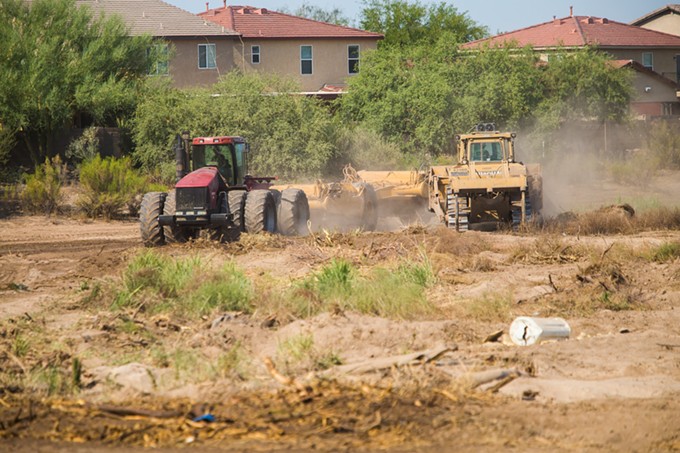A local birding hotspot along the Rillito River between Alvernon Way and Swan Road has recently been destroyed, causing some members of the local Tucson birding community to express concern.
The Columbus Weed Patch wasn't destroyed by vandals with ill intent or by an accidental brushfire, but rather by the Pima County Regional Flood District, which is working to reduce the threat of flooding to nearby homes and businesses.
The Rillito sediment removal and restoration efforts started this month with the goal of removing sediment from the Rillito River to help improve the flow of stormwater during heavy rains. The sediment is being relocated onto the river bank.
Early last week, the bird habitat full of tall grass and shrubs was destroyed, leaving nothing but desolate ground and tire tracks from the heavy equipment used to displace the sediment.
The birding hotspot is a popular local place for birders to visit.
Pima County Regional Flood District officials didn't consult with the Tucson Audubon Society, which works to protect birds and their habitats, about the Columbus Weed Patch prior to the destruction or removal of sediment.
"Tucson Audubon Society is extremely disappointed by Pima County's decision to use the Columbus Weed Patch, a valuable central-city habitat for birds and therefore a highly popular location for birding, as a dumping site for sediment dredged from the Rillito River," said Tucson Audubon Society Executive Director Karen Fogas in an emailed statement.
Fogas said that if there had been communication with the county, things could've ended a bit differently.
"Consulting with the Tucson Audubon Society, which represents a large number of the area's birders, in addition to offering expertise in native plants and habitat restoration, prior to the removal of this habitat might well have led to a more proactive communication with the community as well as to a potentially more positive outcome," Fogas said.
Fogas said the Tucson Audubon Society is ready to help the county when it seeks to re-vegetate the Columbus Weed Patch.
After sending their statement, the Tucson Audubon Society posted on their Facebook page about the destruction and the fact that the society had registered their concern with the flood department. Part of their post said that the Pima County Regional Flood Control District has "pledged to work with Tucson Audubon on a long-term restoration plan, albeit at this unfortunately late point in the process."
Officials from the Pima County Regional Flood Control Department said that they already have a plan in place to restore the vegetation they destroyed for their sediment project.
"It will happen over the next two years but will begin immediately once they place the soil on the site," said Colby Fryar, Rillito sediment removal project manager.
Fryar said the district is removing sediment from the Rillito Creek between Craycroft Road and Alvernon Way to protect nearby residents from flooding.
Fryar said that he was unaware that the weed patch was a local birding habitat.
"We were aware that there were a few sparse large Tamarisk trees, but other than that it was our understanding that there wouldn't be much of a disturbance of any kind of habitat," Fryar said. "It was mostly barren, and kind of just an open area."
He said that there were only some trees, shrubs and grass and that the main bulk of the trees are still on the perimeter and are not being completely destroyed, but rather are being retained.
"We understand that some people are upset," said Laura Fairbanks from Pima County Regional Flood Control. "That's understandable because I guess it was an area that people enjoyed going to, but we needed the area."
Fryar said the county decided to use the Columbus Weed Patch because it owns the property and it would save nearly $5 million by not hauling the sediment off to another location.
"I think the main thing is that we're going to be restoring much of the site and much of the vegetation," Fryar said. "I think over the course of the summer with monsoon rains, it's really going to come back strong and it should become well vegetated."
Fairbanks said in addition to the cost savings, the work in the riverbed will reduce the threat of flood along the area.
"Although they lost that birding habitat on a temporary basis we are planning to revegetate and it will come back," Fairbanks said.










